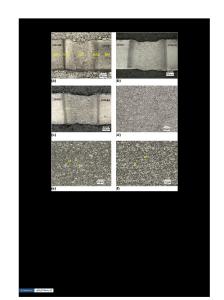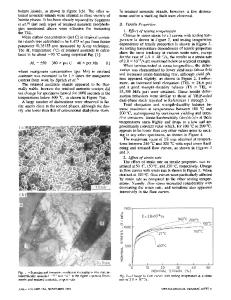Microstructures, Mechanical Properties, and Strain Hardening Behavior of an Ultrahigh Strength Dual Phase Steel Develope
- PDF / 1,844,046 Bytes
- 11 Pages / 593.972 x 792 pts Page_size
- 49 Downloads / 483 Views
INTRODUCTION
IN automotive industries, weight reduction, passenger safety, vehicle performance, fuel efficiency, cost saving, and rationalizing production methods are motives for the development of advanced high strength (AHSS) and ultrahigh strength steels (UHSS).[1–3] As a type of AHSS, dual phase (DP) steel contains soft ferrite with hard dispersed martensite islands, in which the martensite imparts high strength and the ferrite matrix supplies good elongation. The enhancements in formability with a very desirable combination of strength and ductility make DP steels strong candidates for structural applications.[4–7] DP steels have also other unique properties, which include low yield ratio, high strain hardening rate, and continuous yielding.[8] According to the result of the Ultra Light Steel Auto Body–Advanced Vehicle Concept (ULSAB–AVC) partnership project, an automotive body could be constructed by utilizing approximately 85 pct of AHSS, achieving a weight reduction of ~25 pct compared with a bench-marked average base model without any increase of the manufacturing costs. In particular, DP steels occupies quite large portion, over Y. MAZAHERI, formerly with the Department of Materials Engineering, Isfahan University of Technology, 84156-83111 Isfahan, Iran, is now Assistant Professor with the Faculty of Engineering, BuAli Sina University, 65178-38695 Hamedan, Iran. Contact e-mail: [email protected] A. KERMANPUR, Associate Professor, and A. NAJAFIZADEH, Professor, are with the Department of Materials Engineering, Isfahan University of Technology. Manuscript submitted October 18, 2014. METALLURGICAL AND MATERIALS TRANSACTIONS A
70 pct, in the materials selection of ULSAB–AVC project.[9] Although DP steels have better mechanical properties as compared to conventional high strength low alloy steels (HSLA), there is always the desire to improve them further. In particular, the common strengthening mechanisms applied in HSLA steels remain of significance for DP steels, i.e., grain refinement, precipitation hardening, dislocation hardening, and solid solution strengthening. However, the main challenge in producing DP steels is to achieve grain refinement at the same time making them cost effective. Many studies have been done on the fabrication of fine grain DP steels with good mechanical properties using alloying additions. Huang and Gwo[10] studied Fe-2 pctSi-1.5 pctMn steels with three levels of carbon content (0.10, 0.14, and 0.19 wt pct), indicating that the ultimate tensile strength of DP steels increased as the volume fraction and the tensile strength (carbon content) of martensite increased. Terao and Cauwe[11] reported that adding high Mn content (3 wt pct) to DP steels resulted in fine dispersion of martensite leading to higher tensile strength and good ductility. Adding alloying elements like Mo, Nb, Ta, and B led to further improvement of the mechanical properties of the high Mn DP steels. Tsipouridis et al.[12] used C-Mn (0.1 to 1.5 wt pct) steel with 0.8 wt pct Mo and Cr additions to create fine DP stru
Data Loading...











